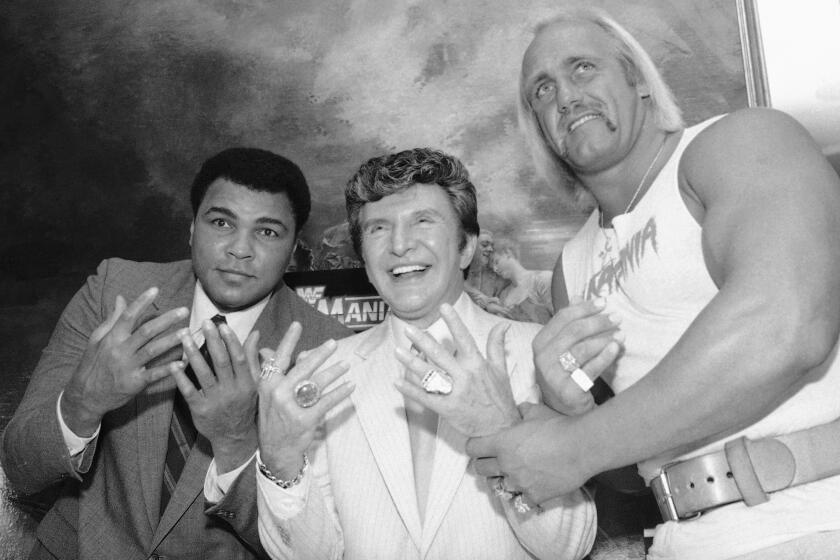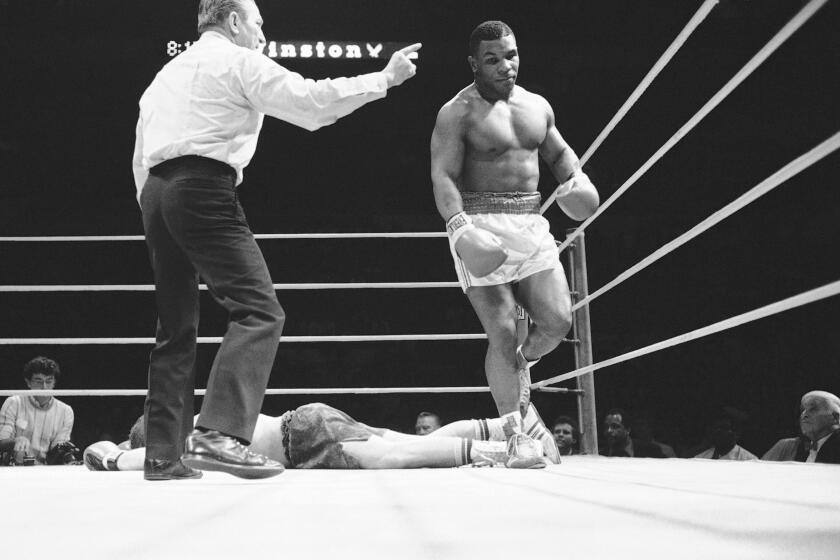Max Schmeling, 99; Boxer Became, for a Time, Symbol of Nazi Germany After Defeating Louis
Max Schmeling, who unwittingly became a symbol of Nazi Germany in two dramatic 1930s bouts with American heavyweight boxer Joe Louis, died Wednesday at his home in Hollenstedt, Germany. He was 99.
According to his foundation, the former world heavyweight champion was buried Friday after a private ceremony at an undisclosed location. No cause of death was reported.
Schmeling’s reign as champion had already ended when he agreed to fight the fast-rising Louis in 1936. The German had become the first European heavyweight world champion in 1930. In an elimination bout for the championship at Yankee Stadium, Jack Sharkey hit Schmeling with a low blow, and the referee awarded Schmeling the victory and the title. Two years later, Schmeling lost the title on a decision in a rematch with Sharkey.
In 1936, Schmeling, 30, was the last legitimate heavyweight who hadn’t tested the undefeated 23-year-old Louis.
After studying films of Louis’ fights -- the Detroit fighter had knocked out 23 of his 27 opponents -- Schmeling said he had seen a weakness he thought he could exploit: When Louis missed with his left hand, he was wide open for a right-hand counterpunch.
Schmeling, in footage of the fight, can be seen cautiously looking for that instant when Louis would miss with a left hand, leaving the left side of his head unprotected.
It happened in the fourth round. Louis reached out tentatively, with a lazy left jab. Schmeling, an 8-1 underdog, rocked back slightly, then delivered a short, smashing right to the left side of Louis’ face.
Louis staggered backward, and Schmeling rushed in, unleashing a flurry of punches. A second big right caught Louis flush in the face, and he went down.
For the next eight rounds, Louis fought like a sleepwalker, unable to emerge from the daze that Schmeling’s first big right had created. Afterward, Louis told reporters he could remember nothing after the third round.
Schmeling ended it in the 12th, catching his opponent with a thunderous right that knocked Louis down. The American sat on his haunches briefly, tried to rise but crumpled, and referee Arthur Donovan counted Louis out as he rolled over on his stomach.
Schmeling’s victory sent shock waves across the Atlantic, and the Nazi regime trumpeted it as indisputable proof of “Aryan supremacy.”
Schmeling, returning triumphantly to Germany on the airship Hindenburg, was greeted as a hero. He lived the life of a country gentleman. He owned a farm and a Berlin apartment. He was married to a glamorous Czech movie star, Anny Ondra, and became an expert trap and skeet shooter.
Those were high times for the man who had been born into humble circumstances Sept. 28, 1905, in a small town in the state of Brandenburg. Schmeling took up boxing after seeing a movie about the sport and discovered he was good at it.
In fact, he was part of boxing’s golden age. He won his first pro fight in 1924, then went on to fight all the major heavyweights of the time: Sharkey, Young Stribling, Max Baer.
Schmeling’s victory over Louis, though, sent him to the top of the popularity charts in Germany. In 1937, Adolf Hitler asked Schmeling to appear at an outdoor reception in Munich for Italian dictator Benito Mussolini. According to an Associated Press report, the ovation for Schmeling exceeded that accorded Hitler.
But Schmeling, during his boxing career, always carried more popularity with the German people than with the Nazi hierarchy. During the 1930s Nazification of Germany, his two main advisors were American Jews: his manager, Joe Jacobs, and his trainer, Max Machon.
Schmeling was scolded once in the mid-1930s by propaganda minister Joseph Goebbels, who said, “Max, you are the only German athlete who is advised by Jews.”
Schmeling, however, refused to sever his Jewish connections, refused to join the Nazi party and hid Jewish friends in his apartment during Kristallnacht, the campaign of violence and intimidation by Nazi hoodlums against German Jews in November 1938.
By then, Schmeling had lost his rematch with Louis. The circumstances for that fight were entirely different. In 1936, they had been two contenders battling in a nontitle bout. But on June 22, 1938, Louis was the heavyweight champion, having beaten James J. Braddock for the title. And Schmeling, sportswriters never failed to point out, albeit incorrectly, was Hitler and Goebbels’ fair-haired boy. “Der Max,” they called him.
Nevertheless, Schmeling seemed to be more popular than Louis that night. His ovation was clearly louder than Louis’ from the crowd at Yankee Stadium. In 1938, many Americans still weren’t ready for a black champion. However, most did appreciate the sweet taste of revenge. And in the stone-faced Louis, they looked at a great athlete in his prime who had waited two years for a chance to fight a man who had humiliated him.
Also, Schmeling was 33, Louis 24. Louis had said little about Schmeling in the two years between the fights, but was surely affected when told of Goebbels-inspired articles in German newspapers stating that Schmeling’s 1936 victory proved that black athletes “lacked the essential courage and mental capacity to stand up under a white boxer of equal ability.”
For 1 minute and 25 seconds, Louis was a determined but careful aggressor. Then, the beating began. Louis backed Schmeling into the ropes and threw a solid right to Schmeling’s jaw. That wobbled Schmeling’s head. Louis threw two more savage punches, Schmeling turning toward the ropes. But there was nowhere to hide.
The fourth punch was a crushing right to Schmeling’s left kidney, a punch that broke Schmeling’s back. Later, his handlers would cry foul. They would also display X-rays, showing a cracked vertebra.
More thundering punches, and Schmeling was desperately in need of a nine-count. But he remained standing. His right hand still clutching the top rope, he looked left, for his corner men, but couldn’t see them. Then he faced Louis again. He looked alone -- and afraid.
He stood there, dazed, while Louis rushed in again. A short left preceded a tremendous right. Schmeling’s head wobbled uncontrollably, and his hair shook like a mop as he plummeted, face-down, to the canvas.
It was high drama, and the entire Yankee Stadium crowd was on its feet, roaring. Thousands who had cheered Schmeling in the introductions had switched allegiances in less than two minutes. In Germany, millions listened at dawn to a hysterical German announcer.
Two lefts and two rights sent Schmeling down again, to all fours. Again, he arose. Again, Louis was on him quickly. He hit Schmeling with another right to the same kidney area and followed with a right to the jaw. Schmeling fell for the third time, and another roar rose up like a great wave from the throng. The count reached four when a towel from Schmeling’s corner sailed into the ring, a European signal -- not recognized in America -- for the referee to stop the bout.
Donovan, who refereed the second fight as well as the first, stopped counting, threw the towel out of the ring, and started to resume his count. Schmeling’s corner men, however, had by then climbed into the ring.
After 2 minutes and 4 seconds, it was over -- possibly the most dramatic and explosive two minutes in American sports to that point. Afterward, Schmeling spent two weeks in a New York hospital, recovering from the cracked vertebra.
As brutal a beating as he had taken, Schmeling said in 1975: “Looking back, I’m almost happy I lost that fight. Just imagine if I would have come back to Germany with a victory. I had nothing to do with the Nazis, but they would have given me a medal. After the war, I might have been considered a war criminal.”
After that loss, the Nazis dropped Schmeling. He was drafted in 1940, served as a paratrooper in World War II, and was decorated for bravery in the Crete campaign.
In fact, Germany mourned Schmeling once before. He was reported killed by the British during fighting on Crete in 1941. His obituary appeared in U.S. newspapers, and numerous boxing figures lamented his passing.
One, ex-champion Jack Dempsey, said: “That’s too bad. He was a great fighter and a great fellow. And he really wasn’t in favor of the Nazis at all. He told me that once in a private conversation.”
Schmeling, it turned out, was alive but ailing -- from food poisoning -- at a German army hospital in Greece.
Like his American rival, Louis, he resumed his boxing career after World War II. He was well past his peak, but he needed the money. After five lackluster performances, he retired in 1948, at age 43.
He tried various business enterprises. He was a mink rancher and tobacco farmer into the mid-1950s, when he became part owner of the Coca-Cola bottling franchise in Hamburg, which eventually made him wealthy again. When Louis, who had gone through a fortune, died destitute in 1981, Schmeling paid for his old opponent’s funeral. His foundation is dedicated to charitable works.
Schmeling’s vigorous health in his later years was a source of constant comment in the German press. He was an avid deer hunter into his 80s.
He and Anny remained married for 54 years before her death in 1987. They had no children.
Bill Westerman, a Coca-Cola executive, told of Schmeling’s visit to Mexico City in 1975 with a group of Coke executives.
“The group was bused to the ancient Teotihuacan pyramids, north of Mexico City, one day,” Westerman recalled. “It was hot, and some of the executives began to complain about having to walk several hundred yards to the pyramids. Max was appalled at their physical condition and said so.
“He was very proud of his good health. To prove it, he ran to the top -- he was 70, mind you -- of the highest pyramid [210 feet], turned and waved to them down below. It simply amazed everyone.”
More to Read
Get our high school sports newsletter
Prep Rally is devoted to the SoCal high school sports experience, bringing you scores, stories and a behind-the-scenes look at what makes prep sports so popular.
You may occasionally receive promotional content from the Los Angeles Times.






